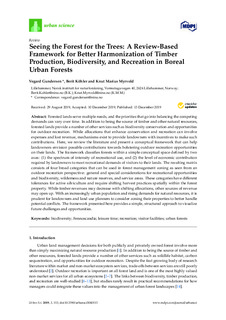| dc.contributor.author | Gundersen, Vegard | |
| dc.contributor.author | Köhler, Berit | |
| dc.contributor.author | Myrvold, Knut Marius | |
| dc.date.accessioned | 2020-01-06T09:56:27Z | |
| dc.date.available | 2020-01-06T09:56:27Z | |
| dc.date.issued | 2019 | |
| dc.identifier.issn | 2413-8851 | |
| dc.identifier.uri | http://hdl.handle.net/11250/2634935 | |
| dc.description.abstract | Forested lands serve multiple needs, and the priorities that go into balancing the competing
demands can vary over time. In addition to being the source of timber and other natural resources,
forested lands provide a number of other services such as biodiversity conservation and opportunities
for outdoor recreation. While allocations that enhance conservation and recreation can involve
expenses and lost revenue, mechanisms exist to provide landowners with incentives to make such
contributions. Here, we review the literature and present a conceptual framework that can help
landowners envision possible contributions towards bolstering outdoor recreation opportunities
on their lands. The framework classifies forests within a simple conceptual space defined by two
axes: (1) the spectrum of intensity of recreational use, and (2) the level of economic contribution
required by landowners to meet recreational demands of visitors to their lands. The resulting matrix
consists of four broad categories that can be used in forest management zoning as seen from an
outdoor recreation perspective: general and special considerations for recreational opportunities
and biodiversity, wilderness and nature reserves, and service areas. These categories have di erent
tolerances for active silviculture and require shifting harvest practices spatially within the forest
property. While timber revenues may decrease with shifting allocations, other sources of revenue
may open up. With an increasingly urban population and rising demands for natural resources, it is
prudent for landowners and land use planners to consider zoning their properties to better handle
potential conflicts. The framework presented here provides a simple, structured approach to visualize
future challenges and opportunities. | nb_NO |
| dc.language.iso | eng | nb_NO |
| dc.rights | Navngivelse 4.0 Internasjonal | * |
| dc.rights.uri | http://creativecommons.org/licenses/by/4.0/deed.no | * |
| dc.subject | Biodiversity | nb_NO |
| dc.subject | Fennoscandia | nb_NO |
| dc.subject | leisure time | nb_NO |
| dc.subject | recreation | nb_NO |
| dc.subject | visitor facilities | nb_NO |
| dc.subject | urban forests | nb_NO |
| dc.title | Seeing the Forest for the Trees: A Review-Based Framework for Better Harmonization of Timber Production, Biodiversity, and Recreation in Boreal Urban Forests | nb_NO |
| dc.type | Peer reviewed | nb_NO |
| dc.type | Journal article | |
| dc.description.version | publishedVersion | nb_NO |
| dc.rights.holder | © 2019 by the authors. | nb_NO |
| dc.subject.nsi | VDP::Samfunnsvitenskap: 200::Samfunnsgeografi: 290 | nb_NO |
| dc.source.pagenumber | 16 | nb_NO |
| dc.source.volume | 3 | nb_NO |
| dc.source.journal | Urban Science | nb_NO |
| dc.identifier.doi | 10.3390/urbansci3040113 | |
| dc.identifier.cristin | 1761957 | |

